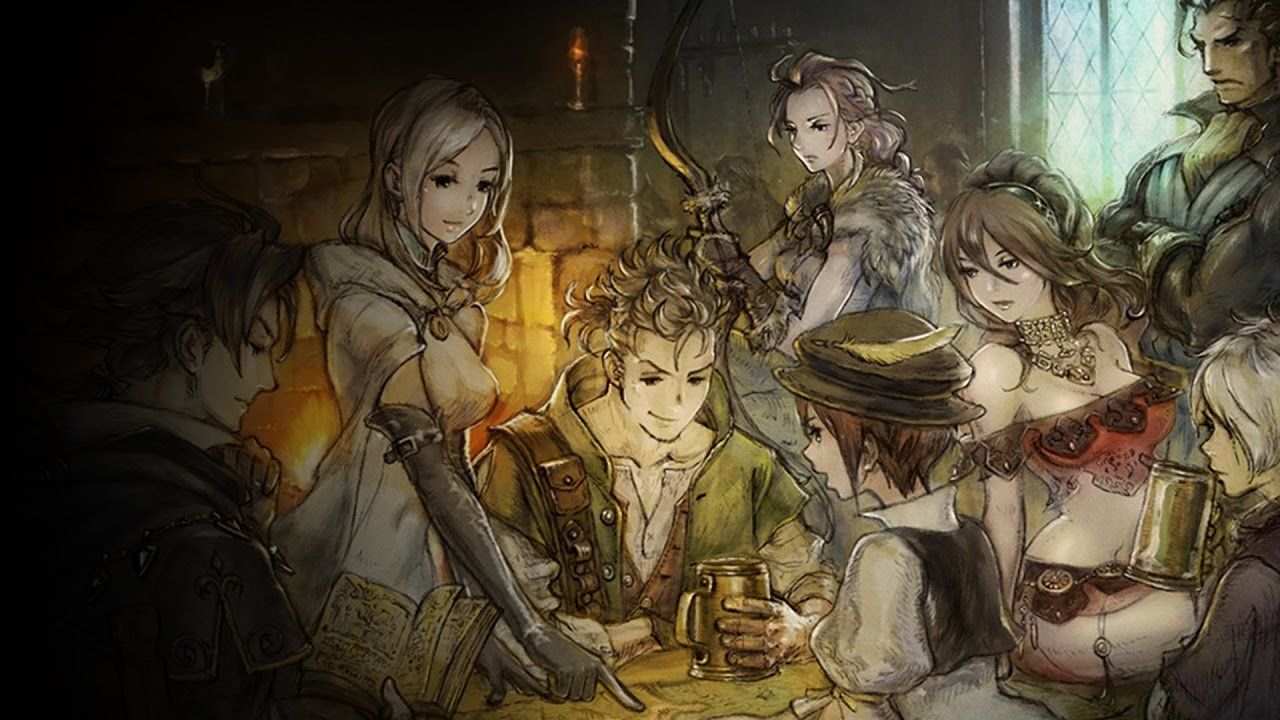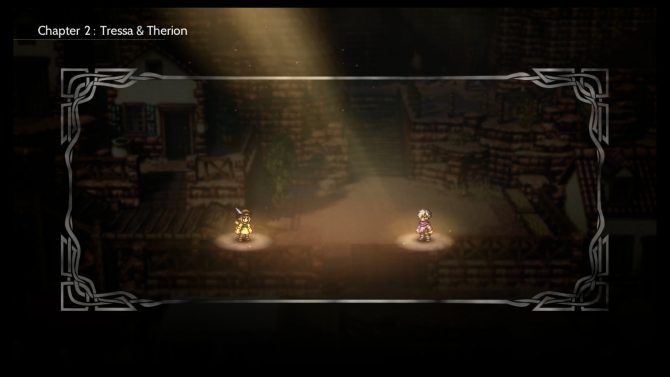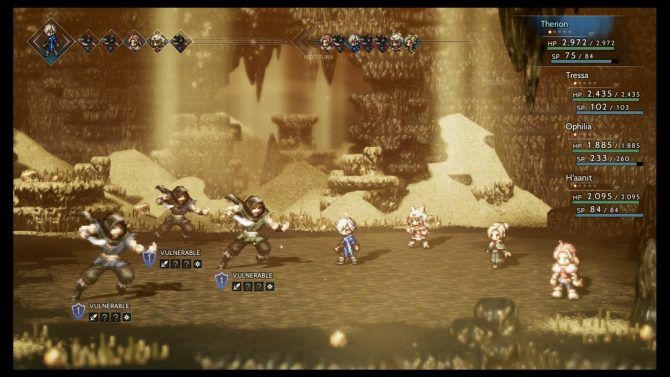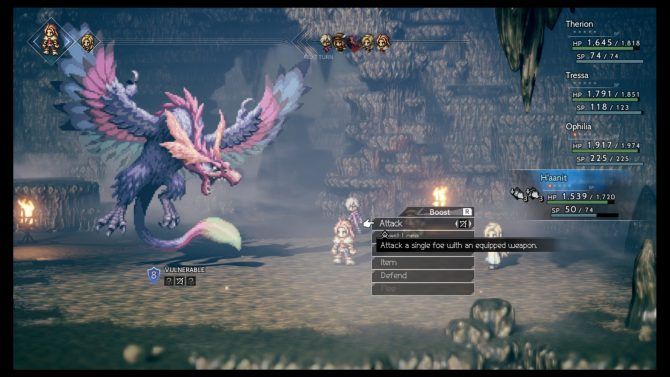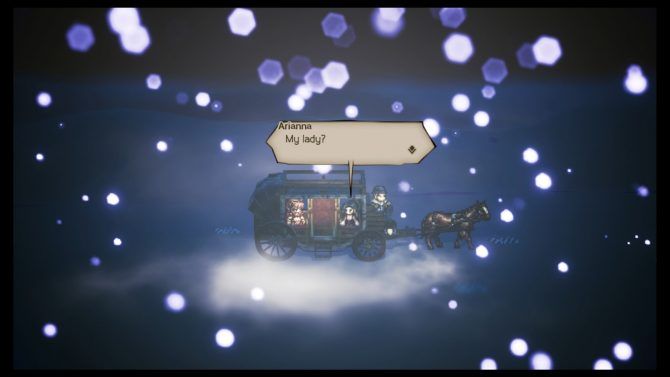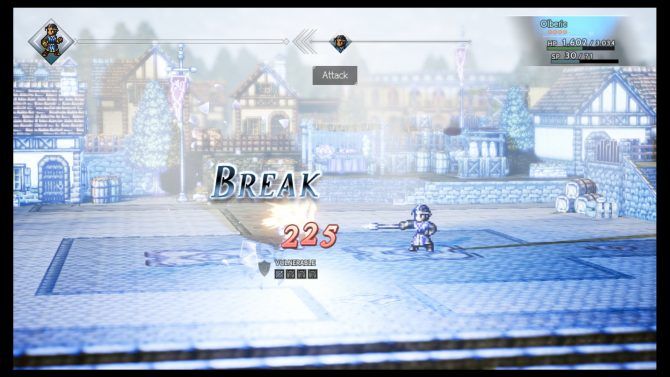While Octopath Traveler pays homage to legendary games that came before it and defined its genre, it surprisingly feels incredibly modern. There are times where Octopath can fall a bit short, but it doesn’t ever fall very far. With Xenoblade Chronicles 2, Octopath Traveler, and a whole slew of other third-party JRPGs, the Nintendo Switch has solidified itself as a fantastic place to experience this iconic genre of video games.
Octopath Traveler’s most glaring issue is its story -- or stories if you will. You play as eight different characters and you can tackle each of their individual storylines in whatever order you want. In fact, you can straight up stop doing someone’s story to go and experience various chapters in other storylines. I was appreciative of the amount of freedom here, but the most significant missed opportunity, in my opinion, is not having these stories interlock with one another.
[pullquote]"...the Nintendo Switch has solidified itself as a fantastic place to experience this iconic genre of video games."[/pullquote]
The closest thing we get to character development amongst the party is short little player initiated bits where each character will give their perspective on where the particular character you're playing as is at in their storyline. Watching these characters interact with one another made me want so much more from the party, many of them have different ideologies, and their varying perspectives play off each other really well. It’s also strange that while the other seven party members don’t appear in cutscenes, they’re always caught up with everything going on, it’s just a little jarring. While some of the stories stay more on the dull side of things, there are some standouts that I won’t get into due to spoilers. The storyline presentation is easily the most bizarre aspect of the game, but the narratives aren’t ever bad enough for me to harp on the game too much for this.
Each storyline spans across four chapters, each with their own recommended level. So if you’re not high enough for one character’s story, you can go to the others that suggest a lower level. That way you can experience almost all the game has to offer at a solid pace that never really feels like it drags. As I mentioned above, I wish these stories felt a bit more connected. But, because there’s no world-ending villain, it could be quite refreshing at times to experience each storyline on a more grounded level; it really gave the world a lot more character seeing the various problems that infected it and how people react to everything.
A specific thing that did become noticeable, especially after I began wrapping up each story, was that Octopath Traveler has a predictable formula when it comes to how it lays out chapters. You’ll always start a chapter by walking into town, having some dialogue between characters, and then exploring a dungeon until you get to that chapter’s boss. This is mostly how every episode plays out, and it’s kind of a shame that it becomes so predictable. Like I said some of the storylines are really interesting, so I didn’t mind this too much. It’s just a shame that the game never really finds new ways to surprise me.
Between chapters, you’ll be doing a lot of XP farming. Luckily, Octopath Traveler has an entertaining combat system that the development team refined from their previous series, Bravely Default. A lot of JRPGs can throw in complex systems with strange names that hinder players' ability to return to the game. But the way Octopath Traveler presents itself is easy to understand and a joy to fiddle with. The strategy elements don’t feel tacked on; they’re smartly incorporated and allow players to discover them at their own pace. It’s also worth mentioning here that the menus outside of battle are easily navigable and presented in a way that’s clear and concise, which is always a good thing in a genre that can sometimes polarize more casual players.
Back on strategy elements; from the get-go, you can start finding different job classes that you can explore with any of the eight characters. Your team will consist of four heroes, each of which can have a subclass equipped on top of their primary class. There’s a lot to mix and match with, and the system added a fun layer of strategy to each battle.
Each class has a mix of passive abilities that you can equip outside of battle, and because there's a good amount of them, you can really make individual characters feel like your own. Some of these skills are more simple like increasing your stamina bar, whereas others allow you to do follow-up attacks after everyone’s move, lower encounter rates, increase rewards after a battle, and more. Also, characters get access to more weapons when they equip a job subclass.
Another cool feature in battles is the break system. Each character has a bar of break points that builds after every turn. If you spend your points correctly, you can attack up to four times, increase skill damage, or make your boost or debuff abilities last longer. Enemies also have a bar of weaknesses below them, and if you stagger them, they’ll be unable to perform actions for one or two turns depending on how you apply your skills. Boss battles, in particular, can get really intense because your enemies will often change up their weaknesses consistently during the fight, making it, so you’ll regularly have to reevaluate your strategy throughout.
For example, one cool moment for me was when I was really stumped on a boss. That particular boss could act before me and make all of my heroes unconscious. But, using the Hunter H’aanit, I used a debuff skill that made it so my adversary was forced to act at the end of every turn. Ultimately, I could break the said enemy, and the boss began only acting every two to three turns. With this in mind, I could adequately prep my team for whatever it might throw at me at the point it could act.
I always kept this particular skill going between H’aanit and another hero that had the Hunter as a subclass. This is just one of the many ways you can overcome fights in Octopath Traveler; it’s all about evaluating your strategies and applying what you think will work best. Also, so many of the game’s bosses have different approaches; there were very few occasions where I went into a big fight with the same mindset as the last. There’s so much room for planning in Octopath Traveler, and it’s all super accessible.
Outside of farming, there are also loads of different side quests you can take on. For these you’ll typically have to utilize one of the eight heroes, using one of the unique abilities they can use outside of battle on townspeople or travelers. It works like this: Olberic, the Warrior of the team can duel people, Therion, the Thief, can steal, and Primrose, the Dancer, can lure people and have them follow her anywhere. You might have someone who’s getting harassed by another individual, they might ask for help. In that scenario, you can duel that individual with Olberic and complete that person’s side quest.
There’s no waypoint for any particular side quest so it’ll rely on you paying attention to who you’re talking to and what they’re saying. I found this decision to be a little bit of a bummer, especially since you don’t get any experience points for completing side quests outside of the quests that have you fight enemies or explore a dungeon. It’s an old school mechanic that hasn’t really transitioned into the modern era too well in my opinion. You’ll typically just be rewarded with items of in-game currency. I did a handful of side quests, but it’s not something I focused too much on outside of conventional farming.
[pullquote]"I have to point out the most striking part of Octopath Traveler: the graphics."[/pullquote]
I have to point out the most striking part of Octopath Traveler: the graphics. I mentioned before it pays homage to the legendary titles that came before it, but Octopath Traveler in its own right will be remembered for years because of its art style and how it truly elevates the entirety of the game. This is not a simple feat and the art team, in particular, deserves all the praise for nailing the style so perfectly. The team has even included a basic option that can change the game’s shadows which is a nice touch for those that care about visual settings.
One point about the art that I’ve seen some people divided over is the way enemies are presented. Regular foes will usually be a bit bigger than your eight heroes, but bosses are generally tremendous in size. It’s a bit unusual, especially when fighting a human enemy, but I have to say I commend this design decision. It really shows how much detail went into making each enemy. I can pull up a bunch of designs I really loved in my head, and that’s definitely due to the art style. In my mind, if they weren’t done this way, they’d just be boring.
[pullquote]"On top of its beautiful art style, Octopath Traveler has an amazing original soundtrack."[/pullquote]
Besides the look of enemies, you have the overall world, which is just visually stunning. I found myself exploring backgrounds, character models, buildings, every little detail is so perfectly crafted, and the lighting system just quite literally makes the world feel like it’s a living, breathing, thing. That fact alone is incredible due to how much this game also relies on older mechanics. There’s some tremendous depth-of-field work here, and I consistently found myself spotting things in various backdrops and thinking to myself, “hey, can I go there? How the hell do I get there?” The team has done a terrific job taking advantage of everything Unreal Engine 4 has to offer on Nintendo Switch.
On top of its beautiful art style, Octopath Traveler has an amazing original soundtrack. It’s a step above many modern JRPGs, but I wouldn’t say it’s as good as some of the top dogs right now like Nier: Automata or Persona 5. I think this is in part due to it being a soundtrack that’s so suggestive of another era. There are plenty of memorable tracks to be found throughout your journey, and they’re just great when accompanying the beauty of the game’s world.
[pullquote]"There wasn’t an hour of gameplay in Octopath Traveler I can say that I didn’t enjoy, which is a feat all its own."[/pullquote]
It’s also worth mentioning that the game has full English and Japanese voice acting that you can change on the fly. I didn’t get much time at all to experience the Japanese voices, but I’d be lying if I told you that wasn’t because I thought the English voice actors did a great job capturing each of the heroes and those you encounter throughout your journey. The voice acting isn’t going to win any awards, but it’s a total treat that it’s there.
Outside of the bounds of this review, I feel like this bears repeating. With Xenoblade Chronicles 2, Octopath Traveler, and other exclusive titles like Shin Megami Tensei V, Pokémon, and Fire Emblem: Three Houses on the horizon, I’d easily say if you’re a fan of JRPGs it’s time to hop on the Nintendo Switch train.
You can see everything Octopath Traveler has to offer in about 60 hours. If you want to do side quests without a guide, that time count could get even higher. Farming never got to the point where I was burned out or genuinely bored. My most significant issues with the game lay in its overall storyline structure, and that’s not even a big issue considering there’s no bad storyline in the game. There wasn’t an hour of gameplay in Octopath Traveler I can say that I didn’t enjoy, which is a feat all its own.

